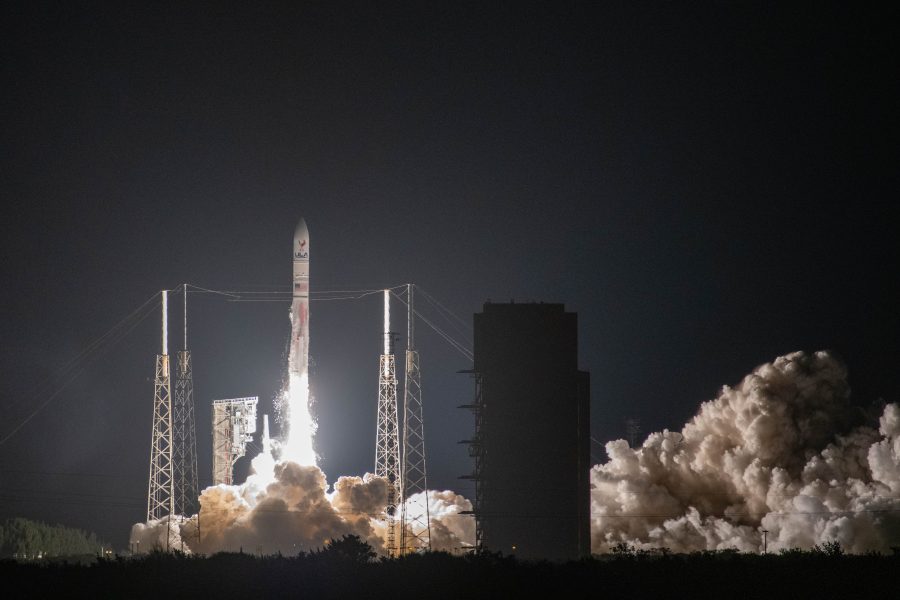NATIONAL HARBOR, Md.—The Space Force is preparing to award billions of dollars in launch contracts by the end of this year—provided Congress passes a budget. If Congress only passes a continuing resolution, the schedule may have to slip.
By the end of 2024, Space Systems Command wants to award a contract for the next phase of its National Security Space Launch program. It also wants to observe a final certification flight from United Launch Alliance’s Vulcan Centaur rocket and see the first certification flight from Blue Origin’s New Glenn vehicle.
All three events are key to Phase 3 of the NSSL program, which will be responsible for launching the military’s most important new satellite systems into orbit from 2025 to 2029.
Brig. Gen. Kristin L. Panzenhagen, SSC’s program executive officer for Assured Access to Space, told reporters at AFA’s Air, Space & Cyber Conference that much work remains to be done. The Space Force took a “dual-lane” approach to this phase—Lane 1 prioritizes commercial-like missions where a higher risk tolerance is allowable, while Lane 2 is for the “most stressing heavy-lift launches” where full mission assurance is essential.
Contract winners will get to compete for task orders for specific missions within the program. ULA, Blue Origin, and SpaceX all got contracts for Lane 1 in June. Source selection is ongoing for Lane 2 and awards are expected toward the end of this year, Panzenhagen said.
“It’s a big important contract, we’re definitely doing a lot of due diligence on that,” she said.
Panzenhagen and SSC commander Lt. Gen. Philip A. Garrant both said the contract award could be complicated if Congress fails to pass a budget by the start of fiscal 2025 on Oct. 1. If they pass instead a a continuing resolution, spending levels will be frozen at 2024 levels and new programs can’t be started.
“Pending a budget, we will make those awards,” Garrant told reporters in a virtual roundtable.
As for launch operations, he added, “We do have the ability to prioritize where our CR funds go, and clearly space lift and National Security Space Launch is important.”
SSC has previously said it will award up to three Lane 2 contracts in a bid to increase competition in a launch market that is now dominated by SpaceX’s Falcon 9 and Falcon Heavy rockets. ULA and Blue Origin are widely considered the top two competitors after getting Lane 1 contracts, but neither company has an active launch system that is certified for NSSL’s most important missions.
Strictly speaking, neither company’s rocket needs to be certified before a contract award—SSC’s criteria only requires that the bidders have a plan to achieve certification by October 2026. However, the criteria also note that “the Government may assign a significant strength or a strength if the offeror demonstrates the proposed Launch System is ready earlier than the required readiness date.”
The upcoming flights of Vulcan and New Glenn could help demonstrate that readiness, though Panzenhagen noted that the NSSL contract award is not waiting for any particular contractor’s flight.
Vulcan is set to launch Oct. 4 with an inert payload for its second certification flight. If all goes well, Panzenhagen said her team will work to make sure the rocket is certified for NSSL missions, which it will have to do to get launches under Phase 2 of the program, where ULA and SpaceX are the only contractors.
“I’m definitely looking forward to that second certification flight. It’s not instantaneous that if they have a clean flight, they’re automatically certified,” said Panzenhagen. “We have a lot of data to go through after that just to make sure that everything performed up to expectations.”
Blue Origin, meanwhile, does not have a firm launch date for New Glenn but is targeting the first half of November. The launch will carry technology from Blue Origin’s Blue Ring logistics vehicle and will be targeted for NSSL certification, the company has said.
“Every time we can get more providers, we’re looking forward to that,” Panzenhagen said. “You don’t have the similar expectations because with Vulcan we had a first flight to look at. This will be the first flight of a brand new rocket, so we’re very excited to see how that performs: the first step of a longer certification path for them.”
The stakes for Lane 2 are particularly high, consisting of nearly 50 missions and encompassing only three providers. Competition for individual missions in Lane 1 will likely grow, as additional providers can join that program via periodic “on-ramps.” Panzenhagen confirmed that her office held an industry day for the next on-ramp last month and expect to release a solicitation next month.
